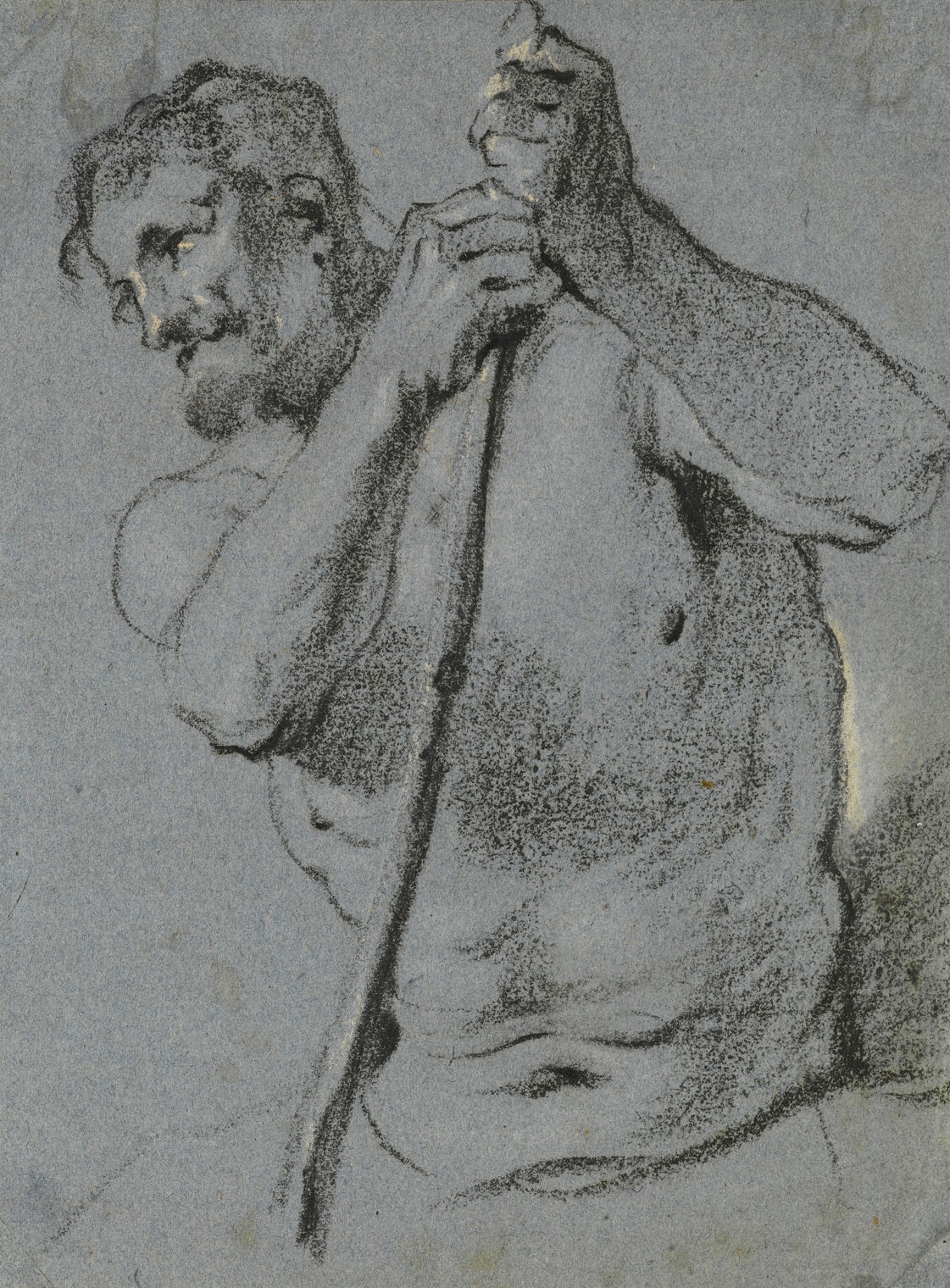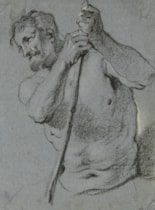Lucas FRANCHOYS THE YOUNGER
(Malines 1616 - Malines 1681)
A Half-Length Study of a Male Nude Holding a Staff
Oiled black chalk, with touches of white heightening, on blue paper.
267 x 199 mm. (10 1/2 x 7 7/8 in.)
267 x 199 mm. (10 1/2 x 7 7/8 in.)
The attribution of the present sheet - previously given to the 17th century Neapolitan painter Giovanni Battista Beinaschi - to Lucas Franchoys the Younger is due to Martin Royalton-Kisch, who made the suggestion in 1988. Only a handful of drawings by Franchoys are known, a few of which are drawn in black (sometimes oiled) chalk and white chalk on blue paper. The influence of the draughtsmanship of both Rubens and Van Dyck is evident in the few drawings and oil sketches by Franchoys that survive.
Among stylistically comparable drawings by Lucas Franchoys the Younger is a study of the head of a bearded man, also in oiled black chalk, in the Frits Lugt Collection (Fondation Custodia) in Paris. Also similar is a study of the head of a man with long hair, drawn in black chalk on blue paper, in the collection of the Rijksmuseum in Amsterdam.
Among stylistically comparable drawings by Lucas Franchoys the Younger is a study of the head of a bearded man, also in oiled black chalk, in the Frits Lugt Collection (Fondation Custodia) in Paris. Also similar is a study of the head of a man with long hair, drawn in black chalk on blue paper, in the collection of the Rijksmuseum in Amsterdam.
One of the few significant 17th century painters to hail from the town of Malines (Mechelen) in Flanders, Lucas Franchoys the Younger was born into a family of artists. He received his artistic training from his father, Lucas Franchoys the Elder, before entering the studio of Peter Paul Rubens in Antwerp in the late 1630’s. He became one of the most talented of Rubens’s followers, although his work also shows the distinct influence of Anthony Van Dyck. After Rubens’s death in 1640, Franchoys may have spent some time working in Paris for the Prince de Condé, although no firm evidence of such a trip survives. His first recorded commissions were received around the end of the 1640’s, for various churches and monasteries in Tournai; among these is an Annunciation in the cathedral at Tournai, which is dated 1649, and a Beheading of Saint John the Baptist, painted in 1650 for the church of Saint-Quentin and destroyed during the Second World War.
Franchoys was back in Malines by 1654, and worked there until his death, establishing a successful career. Among his most significant commissions was a triptych of scenes from the life of Saint Roch, painted between 1669 and 1672 for the church of Saint-Jean-l’Evangeliste et Saint-Jean-Baptiste in Malines, as well as two canvases of The Preaching of Saint Peter and The Preaching of Saint Paul for the same church, completed in 1673. His most important patron was Alphonse de Bergues, the future archbishop of Malines, who commissioned several works from the artist for local churches and monasteries. Best known as a portrait and history painter, Franchoys was registered in the artist’s guild in Malines in 1655, and served as dean of the guild in 1663. He had several pupils in Malines, leading to the diffusion of Rubens’s style in the area.
Provenance
An unidentified collector’s mark VS in monogram stamped in blue ink on the verso
Dr. and Mrs. Victor Bloch, London
Their sale, London, Sotheby’s, 12 November 1964, lot 99 (as G. B. Beinaschi)
Ralph Holland, Newcastle
Thence by descent until 2013.
Dr. and Mrs. Victor Bloch, London
Their sale, London, Sotheby’s, 12 November 1964, lot 99 (as G. B. Beinaschi)
Ralph Holland, Newcastle
Thence by descent until 2013.
Literature
Milford, Christopher Bishop Fine Art, Master Drawings: Catalog 2014, exhibition catalogue, 2014, p.38, under no.12.




